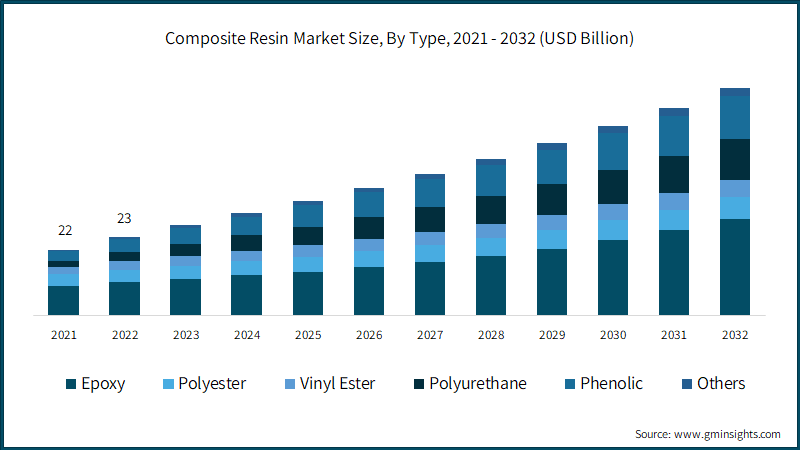Home > Chemicals & Materials > Advanced Materials > Composite Materials > Composite Resin Market
Composite Resin Market Analysis
- Report ID: GMI6157
- Published Date: Jul 2023
- Report Format: PDF
Composite Resin Market Analysis
Based on product, the composite resin market is bifurcated into epoxy, polyester, vinyl ester, polyurethane, phenolic, and others. The epoxy segment reached USD 11.04 billion in 2022. Epoxy resins possess outstanding mechanical properties including high strength, stiffness, and dimensional stability, making them perfect for applications that need structural integrity and stability. Their strong adhesive properties enable them to bond well with various substrates including metals, composites, and plastics. On the other hand, polyester resins are more cost-effective than other resin types, making them suitable for applications where cost considerations are crucial. Vinyl ester resins offer high resistance to chemicals, acids & solvents, increasing their adoption in chemical processing, water treatment, and oil & gas applications.

Based on reinforcement type, the composite resin market is divided into glass fiber, carbon fiber, aramid fiber, natural fiber, and others. The glass fiber segment held approximately 40% of the market share in 2022 and is anticipated to drive at a rapid pace by 2032. Fiberglass reinforcement offers a good strength-to-weight ratio, making it appropriate for applications that need low-weight & robust materials. Carbon fiber reinforcement is used in applications that require high-performance materials and structural integrity as it offers remarkable strength and stiffness.
Based on the manufacturing process, the composite resin market is categorized into hand lay-up, spray-up, filament winding, Resin Transfer Molding (RTM), pultrusion, compression molding, and others. The hand lay-up segment accounted for a dominant market share in 2022 and is poised to grow at over 4.6% CAGR through 2032. Hand lay-up is appropriate for small-scale production or custom-made composite products as it is a relatively simple & cost-effective manufacturing process. The spray-up process enables the speedy deposition of resin and fiber concurrently, leading to quicker manufacturing in comparison to other processes.
Based on end use, the composite resin market is divided into automotive, aerospace & defense, construction, electrical & electronics, marine, sports & recreation, wind energy, and others. The automotive segment held the largest market share in 2022. Composite resins offer low-weight alternates to traditional materials, increasing their demand in the aerospace & defense and automotive industries to enhance fuel efficiency, increase payload capacity, reduce vehicle weight, and improve vehicle performance. The composite resin demand in various other applications depends on specific performance requirements, regulatory standards, cost considerations, and industry trends.

U.S. dominated North America with a high market value of USD 12.42 billion in 2022 and is predicted to expand at a considerable rate from 2023 to 2032. North America composite resin market has a thriving aerospace sector with the presence of major aircraft manufacturers and defense contractors. The need for low-weight materials, increased fuel efficiency, and high-performance components in aerospace applications are propelling the composite resin demand. The regional automotive industry is also emphasizing the reduction of vehicle weight to enhance fuel efficiency and reduce emissions, thereby improving the automotive component performance and proliferating product demand in the North America market.

